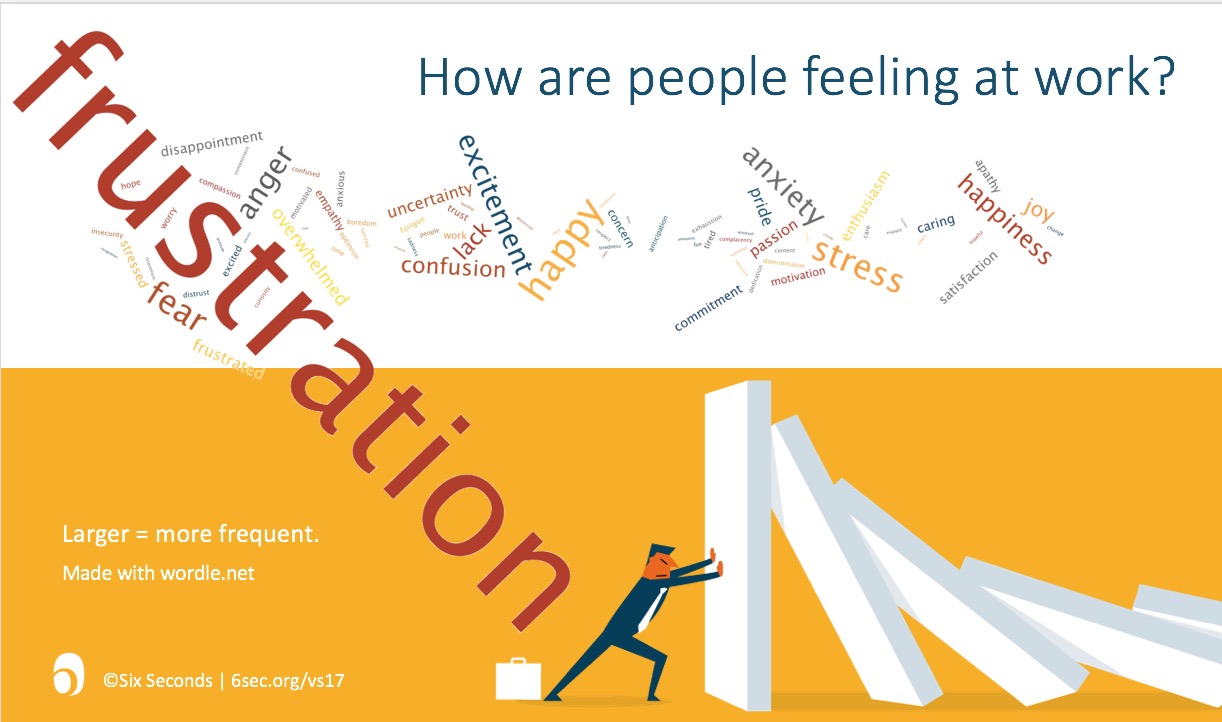Are people in your organization energized and happy or anxious and stressed? Does it matter? New findings from the ongoing Workplace Vitality Study offer important insights into people and what drives performance. Here are three key findings, and a link to download the full report. (Note: The 2020 edition of this study is here)
Six Seconds, a global leader in emotional intelligence, has been surveying workplace vitality for over 10 years and our latest results are now available. The Vitality 2017 report includes responses from 1675 people in 95 countries and reveals critical findings about the level of trust and other key performance drivers, as well as the value of emotions in determining workplace climate.
“New research – Vitality 2017: Finding the value of emotions in the global workforce”
Click to tweet1. Trust Drives Retention, Productivity and More… but it’s LOW
Vitality 2017 delivers the sobering message that trust is low across many types of organizations in different regions, but also shows that rebuilding trust can have a powerful positive impact on Key Performance Indicators such as retention, productivity, customer focus, and future success.
Although trust has the lowest score of all 5 drivers (trust, motivation, change, execution, and teamwork), it impacts 62% of overall performance, clearly showing that the focus, organizationally, should be on building trust.
Top Issues at Work, 2017
1. People Leadership
Poor leadership/management creating lack of communication, little change, and low trust.
2. Great Resources
People don’t have the time, or enough employees on the team, to do the work.
3. Compelling Vision
Short term focus = lack of planning. The vision / direction / goals are not clear.

2. Workplace Issues are Personal. The barriers to employee engagement and high performance are primarily related to emotions and relationships.
With engagement at just over 30 percent, the report discloses the biggest barriers people are facing in the workplace. It also shows that emotional and relational issues are almost 2.5 times more likely to be top concerns than technical and financial ones.
Survey respondents said over 70% of the key issues in their organizations are on the emotional/relational side (rather than financial/technical). The most frequently cited issues are about managers / leaders lacking sufficient communication skills.
3. Mood Matters. The emotional climate is a massive predictor of performance.
Companies with a “negative emotional valence” (aka “bad mood”), are 16x as likely to have poor retention
And what happens when the mood is positive? Get the full report, it’s free. Just fill in the form below to request it.
Frustration may be a fact of organizational life today, but people in companies that embrace EQ express many more positive feelings than people who work where the importance of EQ is not recognized. Trust skyrockets when the mood is positive, while employees are much more likely to leave when the prevailing mood is negative.

Bottom Line: In organizations, actionable data drives positive change
The international survey is built on Six Seconds’ Organizational Vital Signs assessment, a normed, validated tool for measuring and improving workplace climate. Ignite a new commitment to enhance climate, increase engagement, and bolster performance by sharing the insights of the Vitality 2017 report and create a new dialogue about people, emotions, and performance. The form is below.
Learn more about the ongoing Workplace Vitality Study
Note: The 2020 report from the Workplace Vitality study is here)
What's new in emotional intelligence?
Emotional Intelligence at Work: The Free, Easy Win Most Managers Are Missing
Gallup study compares the biggest gaps in employee vs. manager perceptions. What are managers’ worst blind spots? What are easy wins they could do better to improve team performance?
Emotional Intelligence at Work: Is There Hope for Toxic Workplaces?
The remarkable transformation at Westcomm Pump offers a blueprint for turning around workplaces with depleted morale and trust issues, using the Team Vital Signs assessment.
Gen Z Is Unlike Any Generation Before It. New Research Reveals Why – and How to Work More Effectively with the iGen
Here are 3 key insights from the world’s largest study of emotional intelligence, and what it means for working effectively with Zoomers.
Emotional Intelligence at Work: Stress Is (Still) Rising Globally. Here Are 3 Evidence-Based Solutions
Globally, 44% of employees globally reported feeling stressed A LOT of the day yesterday. Here are 3 solutions to reduce stress.
Emotional Intelligence at Work: 3 Steps to End Meeting Madness and Its Emotional Toll
The modern workplace has a meeting problem, and it takes an emotional and financial toll on people. Here are 3 steps to restore sanity.
Emotional Intelligence at Work: 7 Principles to Rewrite the Unwritten Rules of Expressing Emotions
An organization’s emotional culture influences employee satisfaction, burnout and the bottom line. Is it time to rethink your rules?
- Lessons from Patagonia - May 15, 2018
- How to Lead People in a VUCA World: Siemens Case - April 25, 2018
- Practicing Music: Creating Food for the Soul - March 11, 2018








El enfoque de la Confianza es el valor de los valores
Excellent work
Can you name any of the companies that participated in the survey?
Hi Cheryl – sorry, we didn’t ask permission to share company names 🙁
Very helpful. Like it.
Well written- well researched, highly relevant and insightful.
How refreshing to see the stats of how important EQ & the vitality of the workplace is on production, retainability etc… I believe the lack of observation in these area’s
have delayed improvement for many a company. The corporations that address these key components are the ones that will thrive and survive in the long run.
Interesting and helpful.
Knowledge never go waste